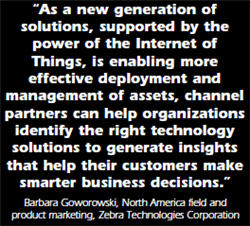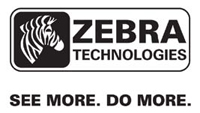The Reality Of The Internet Of Things: How Channel Partners Can Benefit From Internet Of Things Emerging Technologies
By Barbara Goworowski, North America field and product marketing, Zebra Technologies Corporation
 When Kevin Ashton first used the term Internet of Things (IoT), he truly believed that if computers knew everything there was to know about things, without human interaction, it would change the world. This idea that we could gather information, in real time, to help us make better business decisions is proving to be more than just a concept, and is quickly becoming the future of business operations.
When Kevin Ashton first used the term Internet of Things (IoT), he truly believed that if computers knew everything there was to know about things, without human interaction, it would change the world. This idea that we could gather information, in real time, to help us make better business decisions is proving to be more than just a concept, and is quickly becoming the future of business operations.
To explore the rate of adoption and implementation of IoT technologies and solutions, Zebra Technologies commissioned a study by Forrester Consulting to identify insights into how global enterprises are currently investing in IoT technologies. The study defined Internet of Things solutions as smart interconnected devices that businesses use to get more visibility into the identification, location, and condition of products, assets, transactions, or people to drive more effective and timely business decisions or to improve customer interactions.
 So, what does the future Internet of Things look like and what are organizations looking to gain?
So, what does the future Internet of Things look like and what are organizations looking to gain?
IoT Is Not Just A Concept
The October 2012 global study, “Building Value from Visibility: 2012 Enterprise Internet of Things Adoption Outlook,” found that the marketplace appetite for IoT implementation over the next two years is strong. Fiftythree percent of respondents, across various verticals, are planning to implement IoT solutions in the next two years as organizations begin to realize the business and operational benefits this interconnectivity can provide. Additionally, respondents noted the biggest benefits from IoT technology solutions include supply chain visibility (71%), loss prevention (70.75%), and improved customer experience (68.5%).
Drilling down into the verticals, the study surveyed decision makers in the following areas: manufacturing, healthcare, retail and hospitality, transportation and logistics, government and oil, and gas and petroleum. In terms of Internet of Things implementation, the transportation and logistics industry was the furthest along, with 20% of respondents saying they have an IoT solution in place, the highest of all industries surveyed. Healthcare organizations were on the opposite side of the spectrum, with only 3% having an IoT solution in place.
What These Technologies Mean For Channel Partners
This forward momentum toward Internet of Things implementation is particularly important for channel partners, as organizations worldwide are trying to do more with less and are seeking new ways to track and manage their assets. Now, as billions of additional devices are connected to the Internet in the next several years, and the data being collected by those devices continues to grow exponentially, organizations realize the benefits: enhanced supply chain visibility, improved customer interactions, and more.
Channel partners have the ability to help organizations shape their Internet of Things solutions. Here are a few tips for channel partners as they approach IoT solutions with current and potential customers:
A key component of IoT implementation will be prioritizing within organizations. Identify areas of the customer’s business where they will see a quick return on their investment from IoT solutions.
After areas of the business are identified, conceptualize the IoT solutions implementation, including the risks or threats and how the organization can work around them.
 Evaluate solutions providers and find the right solutions to meet the customer’s requirements and needs. An important takeaway from the IoT study is how respondents rated bar codes (72%) and real-time location tracking (71%) technologies as important to bringing value to enabling IoT solutions.
Evaluate solutions providers and find the right solutions to meet the customer’s requirements and needs. An important takeaway from the IoT study is how respondents rated bar codes (72%) and real-time location tracking (71%) technologies as important to bringing value to enabling IoT solutions.
